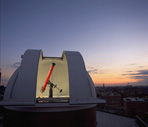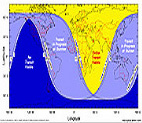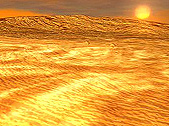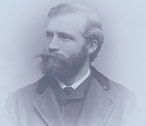|
|
Some materials require the Flash 6 plug-in

|
|


|
 Viewing The Transit
Viewing The Transit
See our spectacular image galleries of the recent ‘ Transit of Venus’ as witnessed by the public and our participating observatories! |
 John Philip Sousa (1854-1932) was very interested in the 1882 transit of Venus. In 1882-3 he wrote his 'Venus Transit March'. Visit this special section of our
website where you can view the cover page of the 1889 sheet music, play the march on your piano, or listen to two complete versions of this enticing score!
John Philip Sousa (1854-1932) was very interested in the 1882 transit of Venus. In 1882-3 he wrote his 'Venus Transit March'. Visit this special section of our
website where you can view the cover page of the 1889 sheet music, play the march on your piano, or listen to two complete versions of this enticing score! |
In the News...
 On June 8th, 2004 a celestial event of historical scientific importance will occur when the silhouette of the planet Venus once again crosses the face of the Sun
as seen from the Earth. This event or transit of Venus last occurred in 1882, so no one alive today has ever witnessed the transit of Venus
On June 8th, 2004 a celestial event of historical scientific importance will occur when the silhouette of the planet Venus once again crosses the face of the Sun
as seen from the Earth. This event or transit of Venus last occurred in 1882, so no one alive today has ever witnessed the transit of Venus |
 For detailed maps and transit times for hundreds of cities, visit NASA's
"Prediction's for the 2004 Transit
For detailed maps and transit times for hundreds of cities, visit NASA's
"Prediction's for the 2004 Transit
of Venus" web page. |
 The Venus Transit Animation
begins at the surface of Venus where heat ripples distort the scene in a shimmering heat bath. As we leave Venus and move off into space, we arrive at Earth and watch as
Venus falls behind us and finally passes across the face of the Sun.
The Venus Transit Animation
begins at the surface of Venus where heat ripples distort the scene in a shimmering heat bath. As we leave Venus and move off into space, we arrive at Earth and watch as
Venus falls behind us and finally passes across the face of the Sun. |
 The
Reanimating the 1882 Transit of Venus Article will explain astronomer David Peck
Todd's observation of the Transit of Venus in 1882. Todd's 147 surviving photos have been converted into a
4.0 MB Movie,
and a 1.2 MB Movie which help to illustrate the event. The
Reanimating the 1882 Transit of Venus Article will explain astronomer David Peck
Todd's observation of the Transit of Venus in 1882. Todd's 147 surviving photos have been converted into a
4.0 MB Movie,
and a 1.2 MB Movie which help to illustrate the event.
|
 Most people, when they think of a "planet", imagine a large roundish body
with a rocky surface and an atmosphere. Forgetting Pluto for a moment (which
has too many issues to deal with here), only Venus, Earth, and Mars share
these characteristics as planets in our solar system. Learn more in our "
VENUS, EARTH, and MARS" comparison website!
Most people, when they think of a "planet", imagine a large roundish body
with a rocky surface and an atmosphere. Forgetting Pluto for a moment (which
has too many issues to deal with here), only Venus, Earth, and Mars share
these characteristics as planets in our solar system. Learn more in our "
VENUS, EARTH, and MARS" comparison website!
|
 Are you Ready for Sun-Earth Day 2005? We will feature both ancient and modern observatories from around the world. Educators will benefit from teacher guides, activities, and a wealth of information. We will also have areas specifically tailored for students, scientists, museums, and amateur astronomer participation. Are you Ready for Sun-Earth Day 2005? We will feature both ancient and modern observatories from around the world. Educators will benefit from teacher guides, activities, and a wealth of information. We will also have areas specifically tailored for students, scientists, museums, and amateur astronomer participation. |
Sun-Earth Day 2004 has selected the transit of Venus as this year's theme. Opportunities are available to
prepare for the viewing of the event. This website has been developed to provide the necessary
resources and opportunities for participation in our fourth Sun-Earth Day. This year's program
will continue to offer new and exciting space science content that will cross all of space sciences,
offering activities and resources for every classroom and museums event. The goal is to involve as much
of the student population and the public in this event as possible and to help them understand the
immense importance and excitement surrounding this and previous transits.
Through engaging activities focused on US and world history, music, technology, math, and astronomy, classrooms and museums can create their own event or participate in one
of the opportunities we make available. Comparisons of Venus with Earth and Mars, calculations of the distances to nearby stars, and the use of transits to identify extra-solar
planets will all add to the excitement of this cosmic occurrence.
While visiting this site don't forget to register for your free educational packet!
Click below for this year's Sun-Earth Day flyer.

Responsible NASA official:
Dr. James Thiemann
Web Manager/Curator: Troy Cline
Web Designer/Curator:
Lori Ann Persichitti Lopez
Additional Credits
NASA
Privacy, Security, Notices
|

